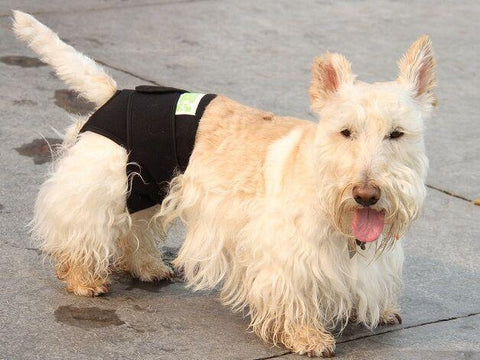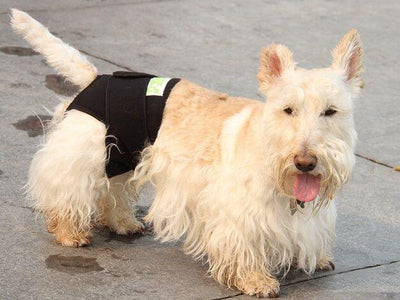Believe it or not, anxiety is perhaps one of the most common issues dog owners deal with. People can be heard lamenting the fact that they can't be away from home for very long without coming home to a destroyed house because the dog is so hyper-attached to them that the animal panics when they are gone.
Just as with humans, living with this kind of anxiety can be very painful and unpleasant for your dog, and can drive you crazy to boot. However, it is easy to recognize the symptoms of the condition and take the appropriate steps to treat them.
Many dogs become anxious when left alone. This feeling of anxiety comes from being cut off from the people they love. Your dog may freak out when you leave for work, but this kind of anxiety is different from true “Separation Anxiety” which usually is diagnosed by a vet, and often manifests in more extreme behaviors like howling and barking all day long while you are away, or causing harm by chewing or scratching themselves repeatedly. Most dogs may initially feel distressed after you first leave the house but will settle down and relax eventually.
Your dog’s anxiety could be the symptoms of fear caused by many different factors in your dog’s environment. Changes to that environment such as loud noises, new furniture, or strangers of the human or animal kind could all trigger your dog’s anxiety. Your dog may also be set off by specific circumstances, like trips to the vet, or car rides in general.
Older dogs may begin to exhibit symptoms of anxiety due to declines in their perception, and awareness. Like humans, many dogs experience memory loss as they age which can be confusing and disorienting. This sense of confusion can cause many dogs to lash out, or display other symptoms of anxiety.
Anxiety comes in many forms:
Aggression: Some dogs become aggressive toward other animals or people when their anxiety kicks in. If your dog is exhibiting aggressive behavior either directly or indirectly toward people or other pets in your household, this can become especially troubling. It is possible to use training and positive reinforcement to correct these behaviors. You may find it helpful to consult a professional dog trainer in these instances.
Non Stop Barking: Repetitive and incessant barking is another aggressive behavior that can often be corrected through training and positive reinforcement, but it may be a good idea to consult your family vet to make sure your dog’s barking isn’t a signal that something else might be wrong. Once you’ve done that, you can then try to slowly desensitize your dog to the experience of being left home alone. It is not recommended to use a shock collar to stop this type of behavior because even if it silences the barks, it isn’t doing much to silence your dog’s anxiety.
Destructive Chewing: If your dog gets themselves worked up to the point that they compulsively chew on furniture you may have success with training your dog not to become anxious when they recognize specific signs of your impending departure such as when they hear the jingle of you grabbing your keys. If you wish to attempt this kind of desensitization training, it is important that you start very slowly and work your way up to longer and longer periods of departure in order to help your dog conquer their fears of being alone. Remember that your dog knows all of your departure cues and associates them with being afraid so it will take time to unlearn that.
Depression or Compulsive Behavior: Anxiety can cause certain dogs to develop compulsive habits such as heavy panting and excessive drooling. It can also cause other dogs to become lethargic and disagreeable, ignoring commands and growling without provocation and going as far as hiding and using the bathroom indoors. It may be helpful for dog owners who deal with this kind of behavior to consult their veterinarian about medicating for the dog to ease their anxiety either through natural means or more serious mood stabilizing drugs in the most serious cases.
Urination or Defecation: In more extreme cases of anxiety, dogs often become so stressed out by the absence of their owners that they find themselves unable to control the urge to urinate or defecate inside. The resulting mess can be unpleasant and stressful to clean up. It can also damage property. This kind of behavior is something you’ll definitely want to correct and put a stop to. This can be accomplished through similar desensitization training methods as mentioned above.
Therapy or Anti Anxiety wraps may help in some cases. These garments work to help the dog wearing them to feel snuggled by the form fitting garment, thus simulating the feeling of being held by their owners. It may also help to heat the garment using a safe method to provide further comfort to your dog.
There are a ton of options for these kinds of wraps, but this is a quick rundown of some favorites on the market.
Healers Pet Care has several offerings to choose from, and they are especially great because of the various choices you have in terms of the size of the wrap. With full body wraps for both small and much larger dogs, as well as a special rear wrap, Healers has presented a versatile line of Therapeutic Wraps. Their wraps also feature heating pads that can be warmed up if needed, and they are made from durable materials that will ensure you get many uses out of the garment.
A second option in the way of calming anxiety is with the Petscent Aromatherapy Collar Clips. These patented, aromatherapy delivery systems clip onto your dog's collar and slowly emit a calming scent by way of 100% therapeutic grade oil blends. The come in two different scents, Calming and Rescue, but contain no perfumes or harsh chemicals.
Your dog’s anxiety may seem like a nightmare to get a handle on, and this might be causing you a fair amount of anxiety if the problem won’t go away on it’s own, or seems to be getting worse. However through careful and patient conditioning it is possible to teach your dog that you won’t be gone forever when you must leave the house. With the aid of therapeutic garments and other supplementary treatments in addition to training and positive reinforcement you can conquer your dog’s fears, and have the freedom of departing for work worry free knowing your dog is at home, relaxing and peacefully awaiting your return.















Leave a comment